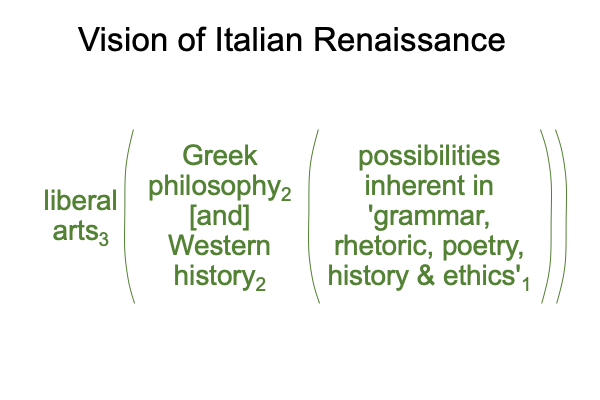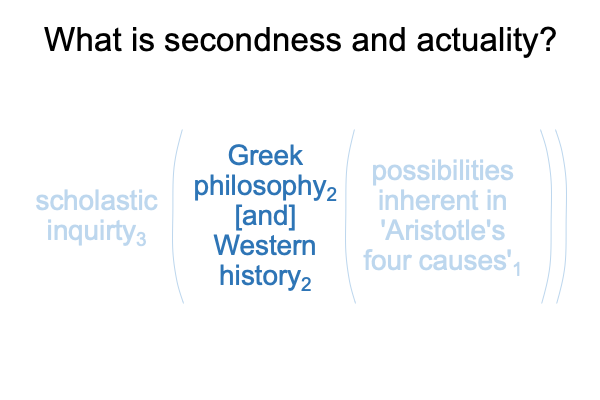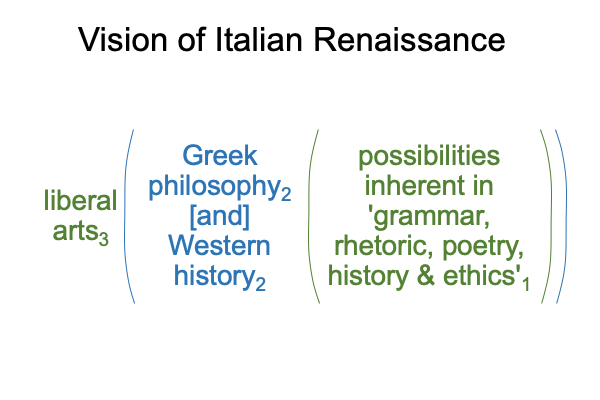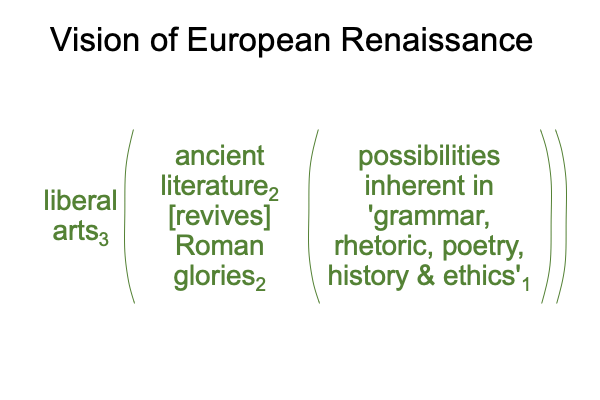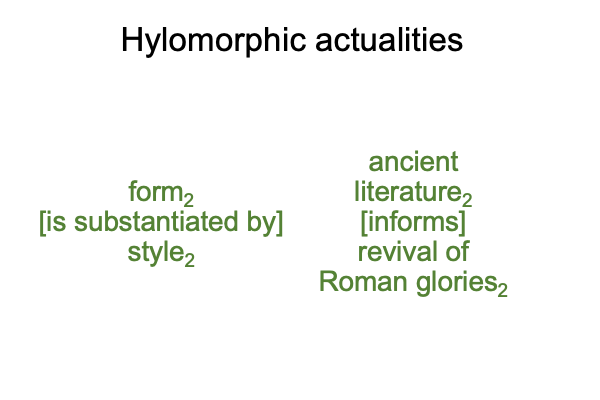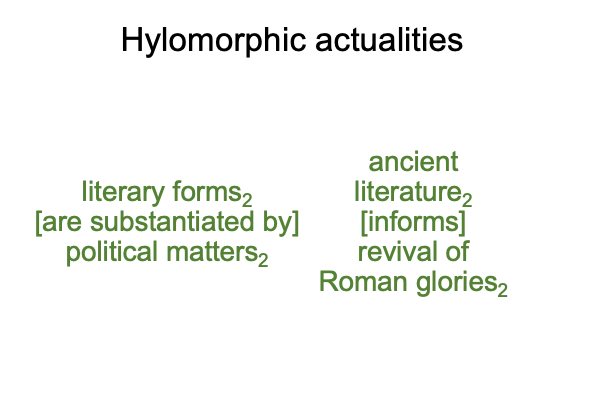Looking at John Deely’s Book (2010) “Semiotic Animal” (Part 1 of 22)
0001 The full title of Deely’s book is Semiotic Animal: A Postmodern Definition of “Human Being” Transcending Patriarchy and Feminism: to supersede the ancient and medieval ‘animal rationale’ along with the modern ‘res cogitans’. The book is published in 2010 by St. Augustine’s Press in South Bend, Indiana.
John Deely (1942-2017 AD) starts as a Thomist interested in Heidegger and becomes a semiotician. He becomes a really, really good promoter of the study of signs. He writes a history of philosophy from the point of view of the revelation… or, is it discovery?.. that the sign is a triadic relation. For years, he teaches at University of Saint Thomas, Houston. He retires, moves to Latrobe, Pennsylvania, home of St. Vincent’s College, then dies.
This examination is to be read in parallel with or after reading (and writing marginalia) in Deely’s book. My argument may run like a dog on a long leash, compared to Deely’s argument. But, there is reason for the analogy. Thirteen years have passed since publication and five years since Deely’s burial, and the Age of Triadic Relations continues to manifest.
Semiotics is the study of signs. A sign is a triadic relation.
0002 Chapter one considers a question that we ask ourselves.
Humans, what type of animals are they?
Chapter two addresses the answer.
0003 Modern philosophy starts (more or less) when Rene Descartes (1596-1650 AD) presents a sensation, as an idea and an image where the object of experience directs a construct of the mind. Consequently, he regards humans as thinking things… or the owners of thinking things (minds)… or something like that.
In terms of Peirce’s philosophy, there are two contiguous actualities, characteristic of the category of secondness. They are an object of experience and a construct of the mind. The contiguity (which, for nomenclature, is placed in brackets) is “directs”.
Here is a picture of Descartes’ dyadic actuality. In Latin, the title is “res cogitans“.
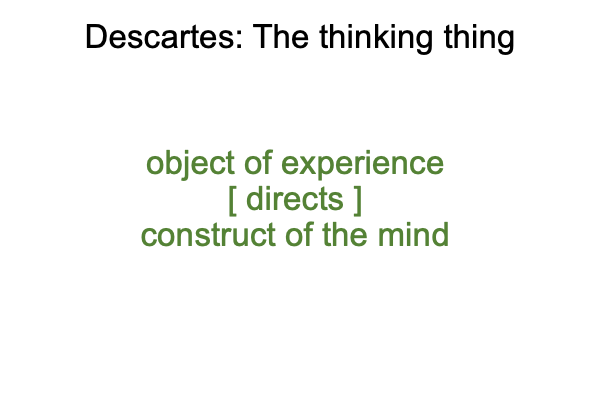
0005 As already noted, this hylomorphic structure is coherent with Peirce’s category of secondness. The actuality corresponds to a sensation. Sensation exhibits a dyadic character. Sensation is like cause [and] effect or matter [substantiating] form.
There is an implicit claim that this dyad describes the way humans think.
Plus, a superior claim (not realized until Charles Peirce (1839-1914 AD) wrote about it) may be asserted. Humans think in terms of triadic relations, such a signs, mediations, judgments and category-based nested forms.
Say what?
See A Primer on the Category-Based Nested Form and A Primer on Sensible and Social Construction, by Razie Mah, available at smashwords and other e-book venues.
0006 With the superior claim in mind, it is no surprise that when later philosophers build epistemologies upon Descartes’ foundation, they end up shifting Descartes’ terms out of secondness, the realm of actuality, and into thirdness, the realm of normal contexts, and firstness, the realm of possibility.
Here is a category-based nested form that sort of captures Kant’s epistemology.
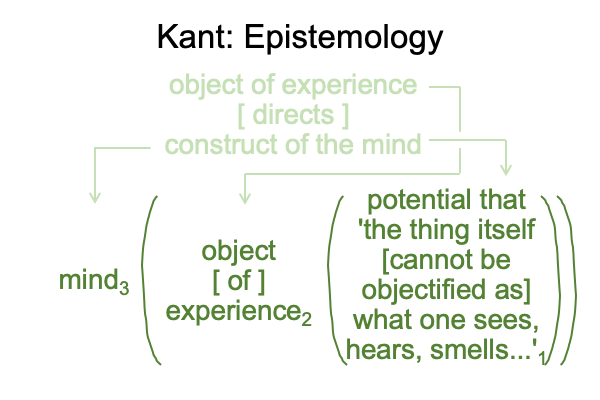
The normal context of the mind3 brings the actuality of an object of experience2 into relation with the potential of a particular condition1. What is that condition? The thing itself [cannot be objectified as] what one sees, hears, smells, tastes or touches.
0007 So, the experience of the five senses2 becomes an object2 as it simultaneously is contextualized by the mind3 and arises from the potential of a particular condition1. Plus, the particular condition1 is that the object of experience cannot be the thing itself1.
It sort of like saying that my image in a mirror is not me, even though I appear to be the object of experience.
0008 Welcome to modern… philosophy?… er… science?
The Positivist’s judgment formalizes the quasi-Kantian category-based nested form by thirdly, replacing the mind3 with a positivist intellect3. The positivist intellect3 rules out metaphysics. Secondly, the object of experience2 is replaced by an empirio-schematic judgment2, where disciplinary language (relation) brings observations and measurements of phenomena (what is) into relation with mathematical or mechanical models (what ought to be). Firstly, the thing itselfand what one senses1 are replaced by Latin terms, the noumenon and its phenomena1.
Here is a diagram of the Positivist’s judgment as a category-based nested form.
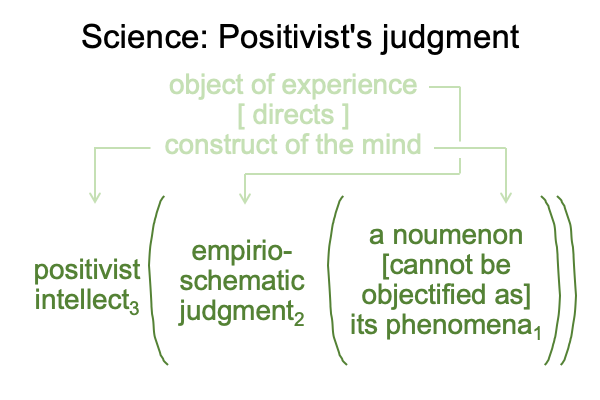
0009 The implications of the conversion of Descartes’ dyadic formula for sensation to a modern quasi-Kantian nested form for how humans think are most curious.
It seems that the construct of the mind weaves a normal context3 and potential1, sort of like a spider spinning a web in the hope of catching a flying insect. The metaphorical flying insect, is an experience2 that immediately becomes an object2as the manifestation of the realness of the normal context3 and potential1. Plus, the object2 is inside of the observer and the thing itself1 remains (potentially) on the outside.
Similarly, for the Positivist’s judgment, the scientist weaves the normal context of the positivist intellect3 with the potential that phenomena1 may be the observable and measurable facets of a noumenon1, then waits for observations and measurements (what is) to reveal patterns that can be modeled (what ought to be) and discussed with disciplinary precision (relation between what is and what ought to be)2. One of the oldest adages in science says, “First, observe phenomena. Second, explain them.”
0010 What a curious implication.
It is almost as if the construct of the mind is looking for an actuality2 that fits its ideals. And when it does, it transforms whatever enters the realm of actuality, such as an experience2 or a measurement2, into an object2 or an empirio-schematic judgment2.


